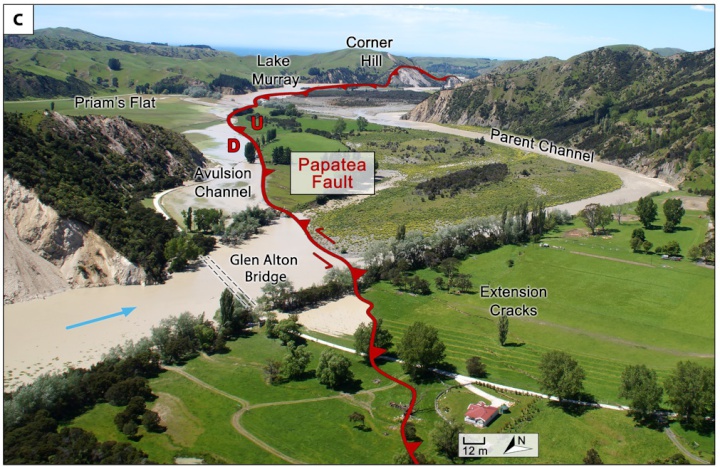New Research Reveals How Earthquakes Can Shift Rivers Out Of Place
Research funded by Toka Tū Ake EQC is filling a ‘gap’ in existing knowledge about the immediate impact of earthquakes on rivers, including changing what we can predict about how they might change course or flood as a result.

Credit: Environment Canterbury. Another example of Erin’s research is above, along the Papatea Fault, where it crosses the parent channel of the Waiau Toa / Clarence River. The fault produced around 6.5 m of uplift downstream of the south-flowing river in 2016, damming it and causing part of the river flow to divert along the base of the Papatea fault scarp. Hectares of farmland was inundated as a result and the river eventually became trapped by the fault a second time near Corner Hill, forming a large lake which lasted for up to eight months before it was drained. Today, the full flow of the river routes along the fault-scarp and has scoured out a new channel up to around 450 m wide, and 4–5 m deep
PhD student Erin McEwan, from the University of Canterbury, hopes it will help to raise awareness around the understudied earthquake multi-hazard.
“I realised early on that there is a gap in the existing research on fault and river interactions, which largely focuses on how rivers respond to fault offset over long timeframes - from decades to thousands of years,” says McEwan.
“There is very little research on how fault surface ruptures within active river channels can lead to immediate flood hazards, despite there being many examples of this phenomenon occurring globally. We need to better understand the immediate impact of surface ruptures during earthquakes, because currently we have no idea what will happen, or how flood hazards may change.“
Dr Natalie Balfour, Head of Research at Toka Tū Ake EQC, says it is the organisation’s mission to share research far and wide and the recent publication in the prestigious journal Science Advances will help with this.
“It’s important for us to fund natural hazard research, so ultimately more people are informed and can be better prepared. Also, being able to share this ‘gap’ in the current knowledge with other countries and scholars is fantastic.
“The publication of this research in such a prestigious journal means Erin’s research reaches more people and makes a bigger difference to other countries with natural hazards. The more we all share our knowledge, the faster we can advance these areas of research,” says Dr Balfour, who adds that Toka Tu Ake EQC invests around $19m in natural hazards research each year.
The support from Toka Tū Ake EQC seems fitting as McEwan first became interested in how natural hazards affect our landscapes when she worked for the organisation following the 2010-2011 Canterbury earthquakes.
McEwan says that as a country prone to earthquakes, with people living near the thousands of rivers across Aotearoa New Zealand, it is important to predict what will happen to those rivers in an earthquake, especially as the shaking could destroy existing flood protection and leave people and critical infrastructure unprotected.
“Earthquakes deform the land surface and can instantly change flood hazards, which is particularly important considering there are fault and river intersections in populated areas such as the Hutt Valley, where the Wellington fault underlies the Hutt River.
“We currently know and prepare what we’d do if rivers flood, but we don’t consider what could happen if an earthquake and flood occurred together,” says McEwan.
“The modelling also showed that flooding following fault-rupture events may not always be instant. Where there is low river flow, initially nothing might happen but in the following days or weeks the river may still flood or change course if river flow rates increase.”
Ultimately, the PhD student hopes the research will be used to boost resilience in our communities.
“I hope we can apply this research more across the whole of New Zealand and start to educate people about how and why these events may happen, so at the very least people are informed.”


 Infoblox: Dancing With Scammers - The Telegram Tango Investigation
Infoblox: Dancing With Scammers - The Telegram Tango Investigation Consumer NZ: This Mother’s Day, Give The Gift Of Scam Protection And Digital Confidence
Consumer NZ: This Mother’s Day, Give The Gift Of Scam Protection And Digital Confidence NZ Airports Association: Airlines And Airports Back Visa Simplification
NZ Airports Association: Airlines And Airports Back Visa Simplification Netsafe: Statement From Netsafe About Proposed Social Media Ban
Netsafe: Statement From Netsafe About Proposed Social Media Ban The Reserve Bank of New Zealand: 2024 General Insurance Stress Test Results Published Today
The Reserve Bank of New Zealand: 2024 General Insurance Stress Test Results Published Today  Worldline: School Holidays And Long Weekends Change Regional Spending Patterns In April
Worldline: School Holidays And Long Weekends Change Regional Spending Patterns In April